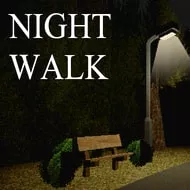

Late Night Walk is a psychological exploration game that transforms an ordinary nighttime stroll into a journey through uncertainty and perception. The experience focuses on movement, atmosphere, and subtle interaction. Players walk through darkened streets and pathways, guided by distant lights and shifting sounds that suggest unseen presence. What appears to be a simple walk becomes a layered narrative about fear, observation, and persistence in solitude.
The core structure of Late Night Walk revolves around continuous forward motion. There are no complex controls or combat systems—progress depends on observation and timing. Each environment introduces small visual and auditory cues that redefine how the player interprets distance, direction, and safety.
This deliberate simplicity builds tension naturally. Every step invites scrutiny of the surrounding space, encouraging mindfulness over action.
Late Night Walk constructs its mood through contrast—stillness against sudden movement, silence against faint echoes. The environment changes imperceptibly, causing familiar areas to feel alien after each pass. Shadows distort with each turn, giving the impression of movement just beyond reach.
These subtle elements create psychological engagement rather than direct fear. The result is unease rooted in anticipation rather than confrontation.
The path in Late Night Walk symbolizes endurance and reflection. The absence of direct objectives allows players to assign personal meaning to events. Each section introduces new visual cues—flickering signs, disappearing footprints, shifting street layouts—that challenge perception and expectation.
Through these mechanics, the game balances narrative ambiguity with a sense of forward momentum, allowing meaning to emerge gradually rather than explicitly.
Late Night Walk invites players to experience isolation as introspection rather than fear alone. Its design emphasizes the human tendency to assign significance to the unknown. Each replay offers a slightly different rhythm or environmental detail, reinforcing the sense that perception defines experience.
By combining minimalism with psychological nuance, Late Night Walk becomes more than a simple journey—it’s a meditation on how imagination shapes understanding when certainty fades.